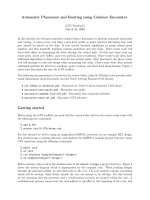Tài liệu Bond markets and banks in emerging economies docx
Bạn đang xem bản rút gọn của tài liệu. Xem và tải ngay bản đầy đủ của tài liệu tại đây (55.97 KB, 7 trang )
42
BIS Papers No 11
Bond markets and banks
in emerging economies
John Hawkins
1
1. Introduction
As the financial system in most emerging economies is centred on banks, an important aspect of the
development of bond markets is the impact on the banking system. One frequently heard worry is that
bond markets could take business away from the banks. This raises some potential concerns for bank
supervisors. On the other hand, if it means firms are less vulnerable to weaknesses in the banking
system, corporate bond issuance can help central banks achieve steady economic growth. Banks also
play an important role in developing a private sector bond market as they are often among the most
important issuers, holders, dealers, advisers, underwriters, guarantors, trustees, custodians and
registrars in this market. Indeed, banks are deriving more of their profits from such activities and less
from lending. For this reason, it is important to have healthy banks to have a sound bond market. And
a bond market may improve the health of banks, by improving market discipline.
2. Competition between banks and bond markets
2.1 The historical development of banking and bond markets
At early stages of development, corporate bond markets are not generally an alternative to the
banking system. The general pattern observed in advanced economies has been for banking to
emerge at a much earlier stage of development than bond markets. In the United States, where the
corporate bond market is most developed, bond market financing overtook borrowing from domestic
banks long ago. In western Europe it has been much slower to develop. Among emerging economies,
the corporate bond market is largest in Korea (in terms of amounts outstanding, although much of this
is little traded). Notwithstanding a major setback following the 1997 crisis, this has been the major
source of funding for corporations there since the early 1990s. Bonds have been increasingly
supplementing bank lending as a source of finance for the private sector in other emerging economies
as well (Table 1).
In cross-economy comparisons (such as the graphs on pages 43 and 95 of this volume), it is notable
that both banking and bond markets tend to be larger, relative to GDP, in rich countries,
2
although
even some rich countries still have small bond markets. As economies mature, banking markets tend
to become developed before bond markets. Yoshitomi and Shirai (2001) and Shirai (2001) suggest
several reasons for this: in poor countries, individuals have a greater preference for liquid short-term
bank deposits; institutional investors are underdeveloped or non-existent; few companies are
sufficiently large and reputable to issue bonds; and the requisite informational, legal and judicial
infrastructure is not in place.
1
Opinions expressed are those of the author and not necessarily shared by the Bank for International Settlements. Thanks
are due to Bill Coen, Craig Furfine, Elmar Koch, Jochen Metzger, Madhu Mohanty, Uwe Neumann, Shirai Sayuri, Peter
Stebbing and Philip Turner for helpful comments. Michela Scatigna prepared the tables.
2
China is a special case as under the socialist market economy banks are prevalent but only recently has a private corporate
bond market developed. Along with its high rate of saving, this has led to bank deposits being large relative to GDP for an
economy at China’s income level.
BIS Papers No 11
43
Table 1
Domestic finance to the private sector
Ratio of domestic bank lending to sum of domestic bank lending and
private sector domestic debt securities on issue (end-year)
1990 1995 1998 2000
East Asia
1
0.85 0.82 0.84 0.85
Latin America
2
0.97 0.81 0.77 0.83
1
China, Hong Kong, India, Korea, Malaysia and Singapore.
2
Argentina, Brazil, Chile, Mexico and Peru.
Sources: BIS; IMF.
2.2 Do bond markets substitute for bank lending?
A much cited simile coined by Alan Greenspan (2000) is that bond markets can act like a “spare tyre”,
substituting for bank lending as a source of corporate funding at times when banks’ balance sheets
are weak and banks are rationing credit. This was the case in the early 1990s in the United States,
and there were some signs of it in Hong Kong in the late 1990s, when domestic banks adopted a
conservative lending stance as property prices collapsed.
3
Conversely, banks may substitute as a
source of funds when bond markets dry up, as occurred following the Russian default in 1998.
An alternative view is that bond markets rarely fulfil this “spare tyre” role. When banks are reluctant to
lend, it is usually a reflection of a general loss of confidence in the economy. At such times, it is also
hard to place corporate paper; indeed, as bondholders generally know the lending parties less well
than do bankers, this form of finance may be even more likely to dry up in adverse times.
An empirical test conducted by Jiang et al (2001) finds that bond issuance and bank lending are
usually positively correlated, in both OECD and emerging economies. An alternative approach, which
focuses exclusively on periods of weak bank lending, is given in Table 2. It suggests that bond
markets more often provide some offset to cutbacks in bank lending, although in most cases only a
very partial offset. (A cautionary note with such studies is that if banks’ non-performing assets are
3
Retained earnings and equity raisings are other important sources of corporate funding.
0
20
40
60
80
0
20
40
60
80
0 5 10 15 20
●
●
●
●
●
●
●
●
●
●
●
●
●
●
CN
IN
KR
MY
AR
BR
CL
MX
PE
ZA
CZ
HU
PL
RU
GDP per capita
3
1
Average over the period 1999-2000.
2
As a percentage of GDP.
3
In thousand of US dollars (PPP adjusted).
Sources: IMF; World Bank; BIS.
Graph 1
Domestic securities
2
Size of domestic securities markets
1
44
BIS Papers No 11
being transferred to an asset management corporation funding itself by issuing bonds classified as
private sector, this could generate a spurious inverse correlation between bank loans outstanding and
bonds on issue.)
Table 2
Corporate bond funding at times of weak bank lending
(change as a percentage of initial domestic credit outstanding)
Domestic bank credit Corporate bonds
United States (1990-93) 1 13
Sweden (1991-93) – 38 – 27
Hong Kong (1997-99) – 16 1
Singapore (1997-99) – 16 1
Argentina (1998-2000) – 7 1
Mexico (1998-2000) – 8 8
Czech Republic (1997-2000) – 26 4
Sources: BIS, IMF, central banks.
Over the longer term, the development of bond markets may have slowed the growth of banks but it
does not appear to have caused their business to contract. Of 25 major emerging economies the
domestic corporate bond market was larger (relative to GDP) in 2000 than in 1995 in all but India and
Brazil. But over the same period, bank lending only contracted appreciably in five economies, and in
these cases the contraction was more a reflection of banking crises than displacement by strong
growth in bonds. There have been reports in Thailand and Hungary of many new bond issues being
used to repay existing bank loans rather than to fund new projects, but this still appears to be the
exception.
2.3 Do bond markets take good lending business away from banks?
Highly rated companies issue more bonds than do lower-rated companies. In general, rated issues are
rated at least A, although there are many unrated issues.
4
This is unlikely to change; of the advanced
economies only in the United States is there a well developed market for lower-rated (“junk”) bonds.
One reason is that many investors are confident about buying securities issued by “blue chip”
companies but feel it is hard to evaluate the credit-worthiness of less familiar companies. In some
countries (eg Malaysia), this reflects policy decisions; in order to ensure the corporate bond market
develops at a measured pace, initially only high-rated companies were allowed to issue bonds, with
the cutoff rating gradually being lowered.
The prevalence of higher-rated bonds may partly be due to regulatory distortions. One factor is that
pension funds and the like are often only permitted to buy investment grade paper. Furthermore,
capital requirements do not distinguish between different corporate risks. For companies with a high
rating, particularly if they are rated better than the bank itself, issuing corporate paper looks attractive.
This raises the issue of whether the quality of banks’ loan books will deteriorate as they lose better
borrowers (one reason why some countries have tried to slow the development of the corporate bond
market). This in turn may drive banks to lower their credit standards.
4
In Korea the majority of corporate bond issues are now rated below A, but were probably rated A or better when they were
issued.
BIS Papers No 11
45
Views differ about the extent to which bond markets will reduce banks’ business. Large companies are
likely to retain a relationship with banks but the nature of that relationship will change. One senior
supervisor suggested that reputable large companies will still borrow from banks for many purposes
such as working capital and good small companies will still rely on banks for funding. Good companies
will also deal with banks because of banks’ role at the centre of the payment system. Firms may also
want to keep credit lines with banks and maintain relationships with them to ensure support in troubled
times when securities may be hard to issue, or hard to issue cheaply or quickly. A bank loan is easier
to restructure than a bond issue. Some companies may prefer to deal with a bank confidentially rather
than face the disclosure requirements of bond financing.
Supervisors may become nervous if the quality of bank loans drops. In principle, lower-quality loans
are not necessarily problematic provided that they are appropriately priced and provisioned, and
adequate capital is held. However, this may not be the case. The task of risk management becomes
harder as loans become riskier, and not all banks may do it well.
Issuance of bonds by companies, giving them more stable longer-term funding, may improve the
quality of remaining loans to them by banks. On the other hand, if companies use bond issuance to
raise their overall debt-equity ratios above prudent levels, it may worsen the quality of bank loans. One
central banker pointed to a possible conflict if the authorities appear to be simultaneously wanting
banks to cut back lending to a sector but also to be encouraging the sector to borrow through the
issue of bonds.
2.4 Do bonds take deposits away from banks?
As bond markets develop, banks may lose the deposits of wealthy customers who seek to earn higher
returns on at least a portion of their portfolio. The main type of bank deposit with which corporate
bonds may compete is the negotiable certificate of deposit. The issue of certificates of deposit gives
the bank secure funding for their typically three to 12-month maturity, and should give the holder a
liquid instrument (although in many emerging economies they may not be very liquid in practice).
However, some of the funds put into domestic bonds may have previously been invested in foreign
bonds rather than in domestic banks. It can be argued that banks are favoured over bond markets by
the authorities, due to the provision of explicit or implicit deposit insurance.
Indirectly, the development of the bond market may reduce demand for bank deposits by stimulating
the growth of the funds management industry. This may particularly be the case when banks pay no or
very low interest on many accounts.
3. Banks as users of bond markets
3.1 Banks as purchasers of bonds
In some economies, banks are major holders of corporate bonds. For example, in Indonesia banks
hold the majority of corporate bonds, and this used to be the case in Argentina, Brazil, Chile and
Malaysia as well. Banks may hold a smaller proportion over time as institutional investors such as
pension funds develop. In some cases (eg Malaysia - but with some exceptions related to corporate
restructuring), banks are only allowed to hold investment grade (BBB or better) bonds.
When bonds (government as well as corporate) form a significant proportion of banks’ balance sheets,
as in India, the question of their valuation becomes significant. With financial systems becoming
largely market-based, there have been increasing requirements for bonds to be marked to market,
making their apparent value more volatile. In some cases, the same bond may be marked to market if
regarded as part of a trading portfolio but valued at cost if held as a long-term investment (and in many
emerging economies banks often hold bonds to maturity).
As well as purchasing bonds for themselves, banks often manage investment and pension funds that
may be significant purchasers. If the bank is also a lender to the company issuing the bonds, it would
have an information advantage in assessing the bonds, but this could give rise to concerns about its
fiduciary responsibilities to fund investors and even “insider trading”. A conflict of interest could arise if
a fund managed by a bank buys bonds issued by a troubled firm which uses the proceeds to repay a
46
BIS Papers No 11
loan from the bank. A challenge for supervisors is to ensure there are effective firewalls within
organisations to prevent such conflicts. Having securities business conducted by a distinct subsidiary
of the bank, or placing banking and securities business in sister subsidiaries under a holding company,
may help in this.
3.2 Banks as issuers of bonds
Banks use bond markets to supplement deposits as a source of funds. Indeed, in many cases (eg
Brazil, China, Germany, India, Indonesia, Mexico, Poland, Russia and Thailand) banks and other
financial institutions account for most domestic bond issuance. Subordinated bond issuance has the
advantage for banks of being recognised as Tier 2 capital. It also has the potential virtue of making
banks more subject to market discipline.
5
Banks specialising in longer-term lending will tend to issue
long-term bonds to lock in funding.
3.3 Banks as securitisers
Where bond markets have been developed, banks may be able to use them to sell off some of their
loans. This may enable banks to economise on capital, reduce maturity mismatches, enhance their
liquidity and diversify (geographically or sectorally) their credit exposures. Often such “securitisation” is
done by parcelling up loans and selling them to a special purpose vehicle which then issues securities
backed by the loans and their underlying collateral. This raises the question of the subsequent role of
the banks with respect to these loans. Purchasers may wish the banks to continue the administrative
role of collecting interest payments. While securitisation contracts may require banks to chase overdue
payments, banks may have less incentive to chase delinquent borrowers after they have sold the
loans. They may even have much less incentive for careful credit assessment if they intend to sell off
the loans soon after they are made.
However, concern about reputation provides some such incentives if the banks wish to use
securitisation regularly. Furthermore, in practice, securitisation is structured to reinforce these
incentives. Purchasers only buy a partial share of the loans or require the issuer of the securities to
overcollateralise them. A more sophisticated version of this is where the securities based on the loans
are divided into tranches, with the upper tranches (paying a lower interest rate) having first call on
repayments.
An alternative approach to this problem is requiring the banks to guarantee full and timely repayment
of loans sold (“securitisation with recourse”). This means that although the loan itself is no longer on
the balance sheet, there is still a contingent credit exposure, as the final credit risk remains with the
bank. Supervisors will therefore insist that capital is held against such exposures (see BCBS (2001)),
thus partly defeating the purpose of the securitisation. A more subtle problem arises when a bank is
under no legal obligation to guarantee repayment of securitised loans but nonetheless feels an
obligation to avoid reputational risk (“implicit or moral recourse”). This is particularly likely for banks
making extensive use of securitisation.
Another possible consequence of securitisation is that, as only the best-quality loans may be suitable,
it may weaken the average quality of banks’ balance sheets. Whether this should unduly concern
supervisors is discussed above.
Securitisation has only occurred in recent years in most emerging economies and is still not practised
in many. One reason is cyclical; in many economies banks are currently very liquid and there are not
many good lending opportunities (and as economies head into recession, banks may prefer to keep
their better loans on their own books). Securitisation seems to be done more by foreign than domestic
banks. It is relatively advanced in Korea, where there are more products with more complicated
structures. In some economies a special case of securitisation – asset management corporations
5
Subordinated debt could generate a better market estimate of bank risk than do equity prices at present. While a
simultaneous increase in risk and expected return could either raise or lower the share price, it should unambiguously lower
the price of subordinated debt. A report by the Federal Reserve Board and US Treasury (2000) concluded that subordinated
debt could potentially increase market discipline. See also Hawkins and Turner (2001) p 448.
BIS Papers No 11
47
established to restructure the banking sector buying non-performing loans and issuing bonds – has
been important.
World Bank and IMF (2001, p 297) lauds securitisation as “an advanced stage of market evolution
[which] allows for better management of balance sheets” but warns that a sound market for securitised
mortgages requires “a land registry system, an effective bankruptcy law, efficient foreclosure
procedures, reliable property valuation, proper mortgage loan underwriting and modern technology in
loan processing and servicing”. Alles (2001) describes how deficiencies in legal, accounting and
taxation issues have impeded development of mortgage-backed securities and other forms of
securitisation in emerging economies. One example is Mexico, where currently sales of assets from an
originator to a vehicle are taxed, unless the originator retains the right to buy back the asset. However,
this conflicts with the approach preferred by supervisors of a “clean break”, unambiguously removing
the asset from the bank’s balance sheet. Another example is Malaysia, where a disincentive to
securitisation is being removed by eliminating stamp duties. Tax issues have been cited as an
important impediment in Thailand as well. Legal impediments are being explicitly addressed currently
in Brazil and Indonesia, and in India a bill facilitating securitisation will shortly be introduced into
parliament. The Basel Committee currently has a group working on ensuring the New Capital Accord
creates neither incentives nor disincentives for securitisation: see BCBS (2001).
Perhaps the area with most potential for securitisation is home mortgages. In emerging economies,
private institutions have often failed to set up such a market. As a result, in both Hong Kong and
Malaysia, the central banks have been instrumental in setting up mortgage corporations, which
purchase mortgage loans from banks and securitise them. Argentina and Korea have also moved to
develop such markets. In Chile the Superintendency of Banks has recently allowed banks to open
their own securitisation agencies. Other areas where securitisation is common in some advanced
economies are credit cards and car loans, other products whose pricing does not depend on
specialised knowledge but more objective criteria such as income and collateral. This could be a
growth area in emerging economies.
A potential benefit for supervisors is that securitisation may give useful market estimates of the credit-
worthiness of companies. This can assist in more accurately valuing banks’ loan books.
3.4 Banks as guarantors
Banks may earn fee income by guaranteeing full, or partial, repayment on corporate bonds (“credit
enhancement”). Since the Asian crisis, there has been both a marked reduction in the willingness of
banks to guarantee bond issues, and a downgrading of the ratings of many banks. In Korea the
proportion of bonds guaranteed has fallen from over 90% to under 10%. In Malaysia, prior to July
2000, the central bank required all corporate bonds issued to be rated investment grade and this
required some form of bank guarantee where the company itself was not sufficiently highly rated.
As with securitisation, this gives rise to an off-balance sheet credit risk, and supervisors will require the
bank to hold appropriate additional capital. In Thailand, banks are subject to a limit of 25% of their
capital in their combined exposure to a company from lending, holding bonds, providing guarantees
and underwriting. Some supervisors prefer specialised institutions, not banks, to provide guarantees.
3.5 Banks as underwriters
Banks may also act as underwriters for corporate bond issues, promising to take up themselves any
shortfalls if corporate bonds cannot be sold at an agreed minimum price (maximum yield). Banks then
take on market risk rather than credit risk. Data on the extent of underwriting are poor, but the extent
varies greatly across economies. It is estimated that over 90% of corporate bonds in Hong Kong are
underwritten. All listed corporate bonds in Indonesia and Korea are underwritten, as are almost all in
Mexico and Hungary. In contrast, only 12% of corporate bonds issued in Malaysia last year were
underwritten, and in Chile and Peru hardly any corporate bonds are underwritten. In some countries
underwriting is limited to securities houses rather than banks. Alternatively, banks may only offer “best
efforts” underwriting, where they make no promise to take up unplaced paper.
In India and Poland, recently, corporate bonds have mainly been sold through private placements with
banks and other financial institutions. There are possible concerns about the lack of transparency in
these practices. The Reserve Bank of India issued guidelines in June 2001 regarding required due
48
BIS Papers No 11
diligence, disclosures and credit risk analysis. Banks have been advised to adopt an internal system of
rating issuers. Further prudential guidelines along these lines are proposed.
Such bond market activities may bring diversification benefits to banks. There may be economies of
scope as banks have access to better information about firms to which they lend than would
independent securities firms, and they can use their branch networks for marketing.
6
However, the
extent of these benefits is arguable, and pricing underwriting is difficult. There is a risk that many
underwriting lines may be called on if the economy slows down. As a result, some supervisors limit
banks’ involvement in this activity. In India, a bank can only underwrite up to 15% of an issue. In
Indonesia, banks are not allowed to do any underwriting; this business is restricted to licensed
securities companies. Underwriting may be best left to foreign banks, with their greater “placement
power” resulting from their large global customer base.
References
Alles, L (2001): “Asset securitisation and structured financing: future prospects and challenges for
emerging market countries”, IMF working paper 01/147, October (www.imf.org).
Basel Committee on Banking Supervision (2001): “Treatment of asset securitisations”, Working paper,
10 October (www.bis.org).
Federal Reserve Board and US Treasury (2000): “The feasibility and desirability of mandatory
subordinated debt”, December.
Greenspan, A (2000): “Global challenges”, remarks at the Financial Crisis Conference, Council on
Foreign Relations, New York, 12 July.
Hawkins, J and D Mihaljek (2001): “The banking industry in the emerging market economies:
competition, consolidation and systemic stability: an overview”, BIS Papers, no 4, August
(www.bis.org).
Hawkins, J and P Turner (2001): “International financial reform: regulatory and other issues”, in S
Claessens and K Forbes (eds), International Financial Contagion, Kluwer Academic Publishers,
pp 431-60.
Jiang, G, N Tang and E Law (2001): “Cost-benefit analysis of developing debt markets”, Hong Kong
Monetary Authority Quarterly Bulletin, no 29, November, pp 1-18 (www.info.gov.hk/hkma). An
abridged version appears in this volume.
Shirai, S (2001): “Searching for new regulatory frameworks for the intermediate financial market
structure in post-crisis Asia”, Asian Development Bank Institute working paper 24, September.
Stone, M (2000): “The corporate sector dynamics of systemic financial crises”, IMF working paper
00/114, June (www.imf.org).
World Bank and IMF (2001): Developing Government Bond Markets: a Handbook.
Yoshitomi, M and S Shirai (2001): “Designing a financial market structure in post-crisis Asia – how to
develop corporate bond markets”, Asian Development Bank Institute working paper 15, March.
6
See Hawkins and Mihaljek (2001, p 35) and Shirai (2001, pp 41-2) and references cited therein for further discussion.









